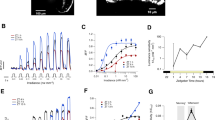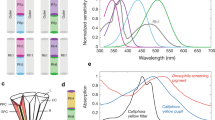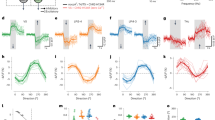Abstract
An array of rapidly inactivating voltage-gated K+ channels is distributed throughout the nervous systems of vertebrates and invertebrates1,2,3,4,5. Although these channels are thought to regulate the excitability of neurons by attenuating voltage signals, their specific functions are often poorly understood. We studied the role of the prototypical inactivating K+ conductance, Shaker6,7, in Drosophila photoreceptors8,9 by recording intracellularly from wild-type and Shaker mutant photoreceptors. Here we show that loss of the Shaker K+ conductance produces a marked reduction in the signal-to-noise ratio of photoreceptors, generating a 50% decrease in the information capacity of these cells in fully light-adapted conditions. By combining experiments with modelling, we show that the inactivation of Shaker K+ channels amplifies voltage signals and enables photoreceptors to use their voltage range more effectively. Loss of the Shaker conductance attenuated the voltage signal and induced a compensatory decrease in impedance. Our results demonstrate the importance of the Shaker K+ conductance for neural coding precision and as a mechanism for selectively amplifying graded signals in neurons, and highlight the effect of compensatory mechanisms on neuronal information processing.
This is a preview of subscription content, access via your institution
Access options
Subscribe to this journal
Receive 51 print issues and online access
$199.00 per year
only $3.90 per issue
Buy this article
- Purchase on Springer Link
- Instant access to full article PDF
Prices may be subject to local taxes which are calculated during checkout





Similar content being viewed by others
References
Hille, B. Ionic Channels of Excitable Membranes 3rd edn (Sinauer Associates, Sunderland, Massachusetts, 2001)
Rudy, B. Diversity and ubiquity of K+ channels. Neuroscience 25, 729–749 (1988)
Coetzee, W. A. et al. Molecular diversity of K+ channels. Ann. NY Acad. Sci. 868, 233–285 (1999)
Sheng, M., Liao, Y. J., Jan, Y. N. & Jan, L. Y. Presynaptic A-current based on heteromultimeric K+ channels detected in vivo. Nature 365, 72–75 (1993)
Wang, H., Kunkel, D. D., Martin, T. M., Schwartzkroin, P. A. & Tempel, B. L. Heteromultimeric K+ channels in terminal and juxtaparanodal regions of neurons. Nature 365, 75–79 (1993)
Salkoff, L. & Wyman, R. Genetic modification of potassium channels in Drosophila Shaker mutants. Nature 293, 228–230 (1981)
Kaplan, W. D. & Trout, W. E. The behaviour of four neurological mutants of Drosophila. Genetics 61, 399–409 (1961)
Hardie, R. C., Voss, D., Pongs, O. & Laughlin, S. B. Novel potassium channels encoded by the Shaker gene in Drosophila photoreceptors. Neuron 6, 477–486 (1991)
Hardie, R. C. Voltage-sensitive potassium channels in Drosophila photoreceptors. J. Neurosci. 11, 3079–3095 (1991)
Hardie, R. C. & Raghu, P. Visual transduction in Drosophila. Nature 413, 186–193 (2001)
Weckström, M. & Laughlin, S. B. Visual ecology and voltage-gated ion channels in insect photoreceptors. Trends Neurosci. 18, 17–21 (1995)
Juusola, M. & Hardie, R. C. Light adaptation in Drosophila photoreceptors: I. Response dynamics and signaling efficiency at 25 °C. J. Gen. Physiol. 117, 3–25 (2001)
Laurent, G. Voltage-dependent nonlinearities in the membrane of locust nonspiking local interneurons, and their significance for synaptic integration. J. Neurosci. 10, 2268–2280 (1990)
Hoffman, D. A., Magee, J. C., Colbert, C. M. & Johnston, D. K+ channel regulation of signal propagation in dendrites of hippocampal pyramidal neurons. Nature 387, 869–875 (1998)
Magee, J., Hoffman, D., Colbert, C. & Johnston, D. Electrical and calcium signaling in dendrites of hippocampal pyramidal neurons. Annu. Rev. Physiol. 60, 327–346 (1998)
Connor, J. A. & Stevens, C. F. Voltage clamp studies of a transient outward membrane current in gastropod neural soma. J. Physiol. (Lond.) 213, 21–30 (1971)
Debanne, D., Guérineau, N. C., Gähwiler, B. H. & Thompson, S. M. Action-potential propagation gated by an axonal IA-like K+ conductance in hippocampus. Nature 389, 286–289 (1997)
de Ruyter van Steveninck, R. R. & Laughlin, S. B. The rate of information transfer in graded-potential neurons and chemical synapses. Nature 379, 642–645 (1996)
Laughlin, S. B. A simple coding procedure enhances a neurone's information capacity. Z. Naturforsch. 36, 910–912 (1981)
Kouvalainen, E., Weckström, M. & Juusola, M. Determining photoreceptor signal-to-noise ratio in the time and frequency domains with a pseudorandom stimulus. Vis. Neurosci. 95, 1221–1225 (1994)
Shannon, C. E. Communication in the presence of noise. Proc. Inst. Radio Eng. 37, 10–21 (1948)
Bendat, J. S. & Piersol, A. G. Random Data: Analysis and Measurement Procedures (Wiley & Sons, New York, 1971)
Hodgkin, A. L. & Huxley, A. F. A quantitative description of membrane current and its application to conduction and excitation in nerve. J. Physiol. (Lond.) 117, 500–544 (1952)
Johnston, D. & Wu, S. M.-S. Foundations of Cellular Neurophysiology (MIT Press, Cambridge, Massachusetts, 1995)
Desai, N. S., Cudmore, R. H., Nelson, S. B. & Turrigiano, G. G. Critical periods for experience-dependent synaptic scaling in visual cortex. Nature Neurosci. 5, 783–789 (2002)
Stemmler, M. & Koch, C. How voltage-dependent conductances can adapt to maximize the information encoded by neuronal firing rate. Nature Neurosci. 2, 521–527 (1999)
Brickley, S. G., Revilla, V., Cull-Candy, S. G., Wisden, W. & Farrant, M. Adaptive regulation of neuronal excitability by a voltage-independent potassium conductance. Nature 409, 88–92 (2001)
Henderson, S. R., Reuss, H. & Hardie, R. C. Single photon responses in Drosophila photoreceptors and their regulation by Ca2+. J. Physiol. (Lond.) 524, 179–194 (2000)
Hevers, W. & Hardie, R. C. Serotonin modulates the voltage dependence of delayed rectifier and Shaker potassium channels in Drosophila photoreceptors. Neuron 14, 845–856 (1995)
Shampine, L. F. & Reichelt, M. W. The MATLAB ODE suite. SIAM J. Sci. Comput. 18, 1–22 (1997)
Acknowledgements
We thank G. Garcia de Polavieja and H. Robinson for comments on an earlier version of this manuscript. The work was supported by the Royal Society (M.J. and R.C.H.) and the Wellcome Trust (M.J., J.N. and R.C.H.).
Author information
Authors and Affiliations
Corresponding author
Ethics declarations
Competing interests
The authors declare that they have no competing financial interests.
Rights and permissions
About this article
Cite this article
Niven, J., Vähäsöyrinki, M., Kauranen, M. et al. The contribution of Shaker K+ channels to the information capacity of Drosophila photoreceptors. Nature 421, 630–634 (2003). https://doi.org/10.1038/nature01384
Received:
Accepted:
Issue Date:
DOI: https://doi.org/10.1038/nature01384
This article is cited by
-
Stimulator compensation and generation of Gaussian noise stimuli with defined amplitude spectra for studying input–output relations of sensory systems
Journal of Comparative Physiology A (2023)
-
Distinct expression of potassium channels regulates visual response properties of lamina neurons in Drosophila melanogaster
Journal of Comparative Physiology A (2020)
-
Performance of blue- and green-sensitive photoreceptors of the cricket Gryllus bimaculatus
Journal of Comparative Physiology A (2014)
-
Membrane filtering properties of the bumblebee (Bombus terrestris) photoreceptors across three spectral classes
Journal of Comparative Physiology A (2013)
-
Cellular elements for seeing in the dark: voltage-dependent conductances in cockroach photoreceptors
BMC Neuroscience (2012)
Comments
By submitting a comment you agree to abide by our Terms and Community Guidelines. If you find something abusive or that does not comply with our terms or guidelines please flag it as inappropriate.



